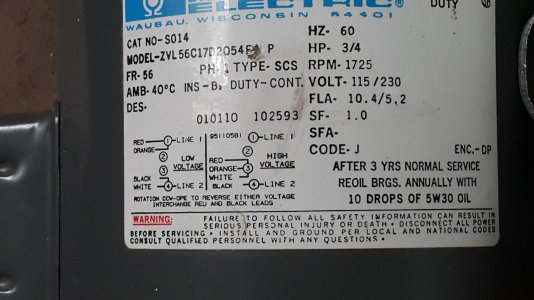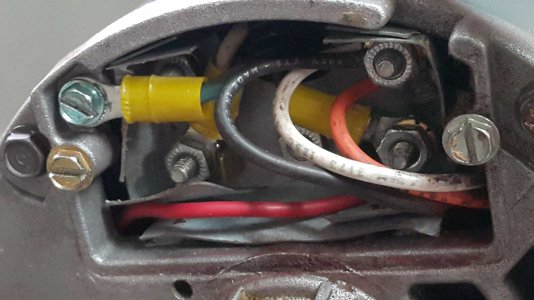I want to put a 3/4 hp motor on my bandsaw (woodworking type). I have a Marathon electric that I have been using for 25 years as a bench buffer. I would like to reverse the polarity to run it the other way to drive the saw without modifying the table, etc.
I have used it for years as purchased new. This is a dual voltage motor, and it has been running on 230v. I opened it up, reversed the two leads as directed on the label, plugged it in and it tripped the breaker. I have 120v in my shop, and have used this motor on 230, but I wired it up for low voltage, reverse polarity, and it still trips the breaker.
I switched the polarity back to low voltage, original direction, and it works fine. Back to hi voltage, original direction and it works
So I have a motor that works fine wired to run CCW on either hi or lo voltage in a 120v shop. According to the label, I can reverse the polarity to make it run CW. However, neither hi nor lo voltage with reversed polarity will work.
I did install a new power cord on this. Does it matter which is Line1 and which is Line2 (black or white from the wall)? If so, why does it work one way and not the other? I thought AC switched direction all the time.
Any idea what is going on?
BTW in the picture of the wiring, starting from the bottom left and going CCW, the studs are #1, #4 (across the bottom along the red wire), #3 (with black, orange and white attached), and #2 is hiding behind the ground. The screw in the middle is not involved
I have used it for years as purchased new. This is a dual voltage motor, and it has been running on 230v. I opened it up, reversed the two leads as directed on the label, plugged it in and it tripped the breaker. I have 120v in my shop, and have used this motor on 230, but I wired it up for low voltage, reverse polarity, and it still trips the breaker.
I switched the polarity back to low voltage, original direction, and it works fine. Back to hi voltage, original direction and it works
So I have a motor that works fine wired to run CCW on either hi or lo voltage in a 120v shop. According to the label, I can reverse the polarity to make it run CW. However, neither hi nor lo voltage with reversed polarity will work.
I did install a new power cord on this. Does it matter which is Line1 and which is Line2 (black or white from the wall)? If so, why does it work one way and not the other? I thought AC switched direction all the time.
Any idea what is going on?
BTW in the picture of the wiring, starting from the bottom left and going CCW, the studs are #1, #4 (across the bottom along the red wire), #3 (with black, orange and white attached), and #2 is hiding behind the ground. The screw in the middle is not involved



